Exploring DSO Brand Structure: The Pros & Cons of Branded vs Unbranded DSOs
Two Approaches to Branding for DSOs: Choosing the Right Strategy for Your Organization When launching a Dental Service Organization (DSO), one of the most important
Digital Advertising & Marketing & SEO & Website Design
Everything you need to know about dental marketing
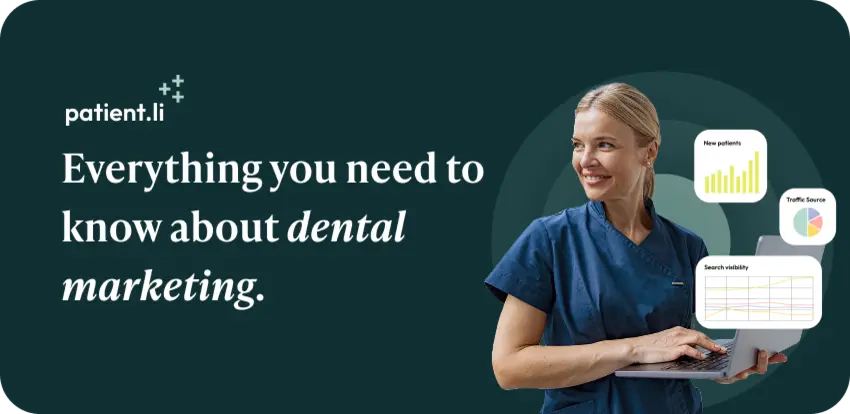
If you’re a dentist or work in a dental practice, you already know that effective marketing can transform your ability to attract new patients, grow your business, and build a strong reputation. But figuring out how to do that successfully can feel overwhelming. The internet is full of vague, oversimplified “top 10 tips” lists that barely scratch the surface of what it really takes to market a dental practice effectively.
That’s where we come in.
At Patientli, we’ve helped dental practices across the country not only attract new patients but also maximize production from existing ones—ultimately helping practices thrive. We created this in-depth guide to give dentists, practice managers, and team members the knowledge and strategies they need to make smart, data-driven marketing decisions.
Too many dental offices struggle with outdated websites, ineffective marketing tactics, and misinformation about what actually works. The truth is, many marketing services aren’t transparent about their strategies, leaving dentists unsure whether their investments are truly driving results.
We built this course to change that.
By breaking down proven, research-backed marketing strategies, we aim to make you a better-informed and more empowered buyer of marketing services. And if you don’t yet have the budget to hire outside help, this guide will share some DIY tactics that will help you make progress towards a future in which you can afford to involve a trusted partner to manage your marketing strategy… ideally us, but there’s no pressure there.
We’ve also published this guide to create a more accountable industry—one where dental professionals understand why certain tactics work and how to implement them effectively. Whether you’re a new practice trying to gain traction or an established office looking to refine your marketing approach, the information in this guide will help you navigate the digital landscape with confidence.
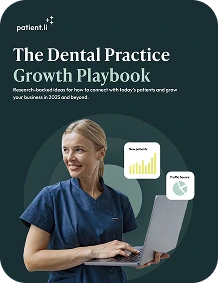
This guide covers the exact strategies that drive patient growth in today’s digital-first world and the research that backs them. We back up everything with real data, industry research, and actionable best practices, and we’ll continue updating this guide as marketing trends evolve. Bookmark this resource or subscribe to stay informed as the digital landscape shifts.
Click any of the items in the table of contents below to jump straight to it.

The process of choosing a healthcare provider has changed dramatically in the digital age. Gone are the days when word-of-mouth referrals and simple listing in the yellow pages were enough to bring in new patients. Today’s patients want to be active participants in their healthcare decisions, and have the power to undertake extensive and highly personalized research before committing to a provider.
A patient’s journey to booking an appointment rarely follows a straight line. Some start with a Google search, while others turn to their insurance provider’s directory, browse social media, or read online reviews. The ease of access to information means every patient’s path is unique, influenced by how much they already know about their needs and the type of care they seek.
During this research phase, patients will typically:
For practices, this means standing out across multiple touchpoints is crucial—a fragmented or weak online presence can cost you new patient opportunities.
of patients use reviews to evaluate providers
Source: SoftwareAdvice
of millennial patients validate a provider’s recommendations with their own research.
Source: Harmony Healthcare
If your practice makes it into a prospective patient’s shortlist, the competition is far from over. They will likely compare you to at least one or two competitors—many of whom are larger, more aggressive with their marketing, and highly optimized for visibility.
Patients ultimately book with the provider that feels like the best fit—the one that is:
✅ Easy to find – Visible in search results, directories, and social platforms.
✅ Well-reviewed – Supported by strong patient testimonials and ratings.
✅ Polished & professional – Featuring a modern website and engaging digital presence.
✅ Simple to book with – Offering online scheduling, clear pricing, and seamless communication.
Only after this extensive digital journey does the provider get their chance to impress in person—but even then, the patient’s perception continues to be shaped by factors outside of the treatment setting, such as pricing transparency, follow-up communication, and the ease of doing business with your practice.
In an increasingly competitive market, understanding and optimizing for the entire patient journey—not just the in-office experience—is what separates growth-driven practices from those that struggle to keep up.
In the following sections of this guide, we’ll touch on several of the specific tactics that high-growth practices use to stand out across the patient journey, from the first impression to booking, recare and recommending the practice to their family and friends.

Imagine starting your day with a new patient on the schedule. You’ve probably thought through how you’ll make them feel welcome—how you and your team present yourselves, the small talk that puts them at ease, the way you discuss their dental health and treatment options. You want to make a great first impression so they trust you with their care for years to come.
But here’s the thing: this isn’t actually their first impression of you.
With 48% of patients spending two or more weeks researching providers, they’ve already formed expectations about you—long before they ever step foot in your office. Their perception is shaped by their online interactions with your practice, from your website and social media to the tone of your receptionist over the phone. Even their pre-existing attitudes about dentistry itself play a role in how they view you before you ever get the chance to make a personal connection.
As it turns out, market research shows that dentistry has a perception problem, and nowadays, first impressions are made long before a patient first sits in your chair.
When it comes to dentistry, public perception isn’t always favorable. Patients often associate dental visits with:
❌ Uncomfortable environments – Harsh lighting, loud noises, clinical smells
❌ Stress and anxiety – Fear of pain, judgment, or unexpected costs
❌ Frustrations with the process – Long waits, outdated tech, unclear pricing
In national consumer satisfaction surveys, dentistry ranks alongside cable companies. That’s a tough place to start.
If your practice looks and feels like every other dentist’s office, patients will assume you’re just like every other dentist. And that means you have to work even harder to overcome negative associations before you even get the chance to deliver an exceptional patient experience.
It doesn’t have to be this way.
The most innovative and fastest-growing practices recognize that branding is their true first impression—a way to shift patient expectations before they even book an appointment. A strong brand gives you the power to:
✅ Stand out from competitors and avoid blending into the “average” dental experience
✅ Break negative associations with dentistry before they impact a patient’s decision
✅ Create excitement and trust before a patient ever walks through your doors

A prime example of branding done right is Tend, a dental startup that has raised over $200 million and opened 30+ locations across the East Coast.
Tend isn’t succeeding by accident—it’s winning patients by reinventing the way dental care is perceived.
Their approach?
The result? Patients click more, engage more, and book more—all because their first impression feels better than what they expect from a typical dental office.
And when those patients finally arrive, they walk in excited instead of anxious. This means Tend’s providers don’t have to work as hard to overcome skepticism—they can focus on delivering an experience that cements long-term trust and loyalty.

If you’re thinking, That’s great, but Tend has a massive budget—how can I compete?—you’re not alone. Many independent practices assume this level of branding is out of reach.
It’s not.
At Patientli, we make great branding, web design, and marketing accessible—even for small and independent dental practices.
With Patientli Looks, you can choose from professionally designed visual identities that instantly modernize your brand—without the high costs, long timelines, or uncertainty of a traditional creative process.
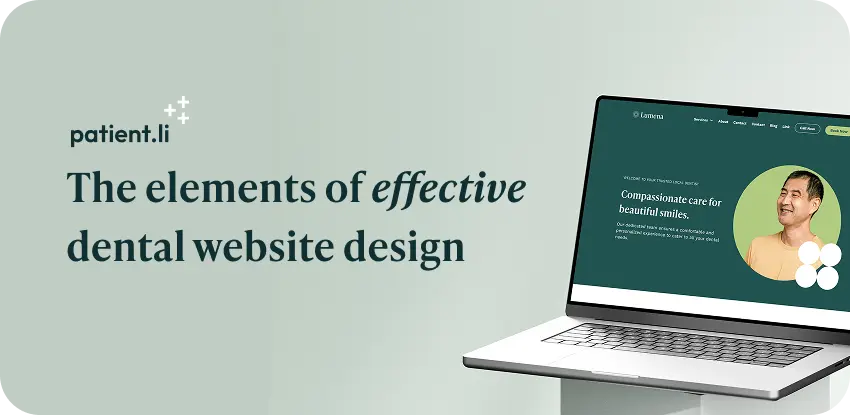
Long before a patient ever steps into your office, they’ll visit your website.
A great website isn’t just a digital business card—it’s the foundation of your marketing strategy. It powers your SEO efforts, serves as a landing page for ads, and houses educational content that builds trust, answers questions, and empowers patients to make informed decisions about their care.
A well-designed website doesn’t just look good—it attracts, informs, and converts new patients. To turn your website into a patient-attraction machine, make sure it includes these essential pages:
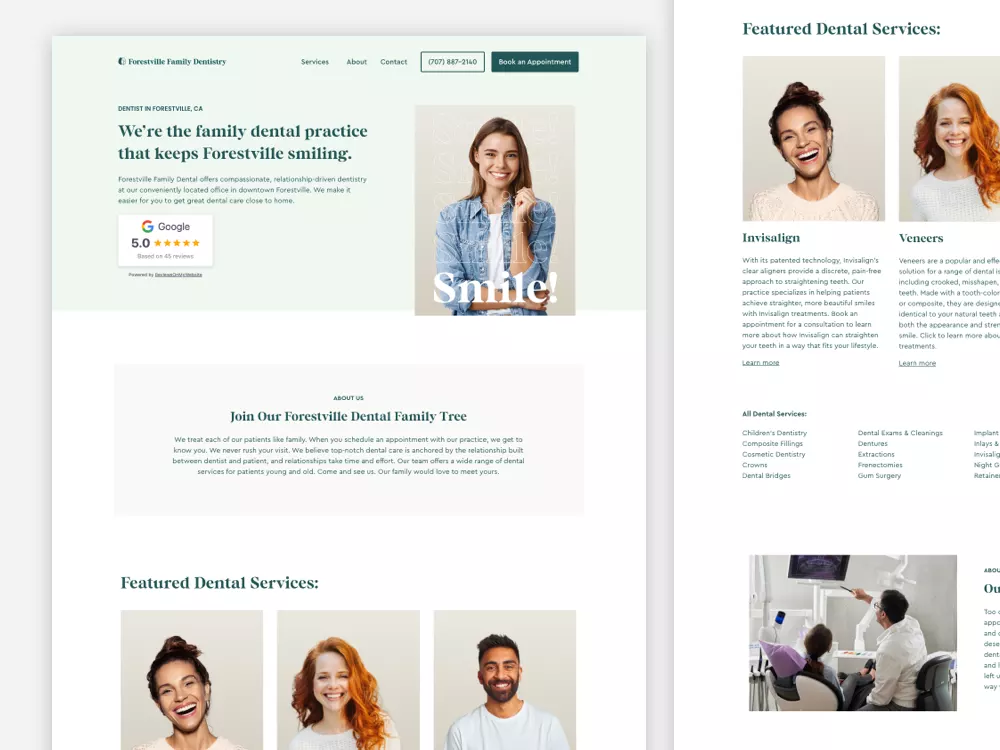
Your homepage is the most powerful page on your website—both in terms of SEO and patient perception.
It’s likely the first thing a potential patient will see, and if it doesn’t grab their attention fast, they’ll move on. Great homepages strike a balance between:
✅ Compelling visuals – High-quality images and a modern, clean design that makes a great first impression.
✅ Clear, engaging text – More than just slick videos—your homepage should clearly communicate what you do and how you help patients.
✅ SEO optimization – Including sufficient text about your practice and services helps Google understand your business and rank your site in search results.
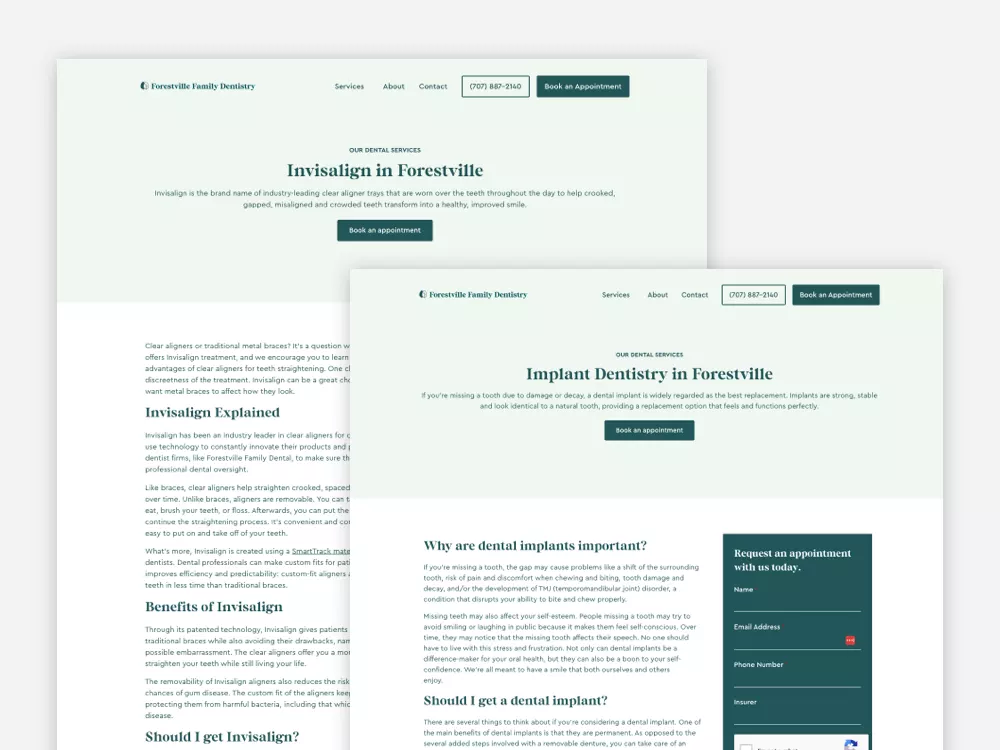
While every practice wants to rank for “dentist near me” searches, the best patients often search for specific treatments—and those searches are often less competitive than general terms.
That’s where dedicated service pages come in.
Practices that build individual pages for services like dental implants, Invisalign, or veneers are far more likely to rank when patients search for those treatments. A strong service page:
✅ Explains the procedure in a clear, patient-friendly way
✅ Answers common concerns to help patients feel comfortable
✅ Includes high-quality images or patient success stories
✅ Features a strong call to action—like “Request a Consultation”
If you’re serious about SEO and patient acquisition, service pages aren’t optional—they’re a must-have.

Patients don’t just choose a dental practice—they choose a dentist.
That’s why provider profile pages are some of the most visited pages on any dental website. A great profile page helps patients feel comfortable and confident about their choice by showcasing:
✅ A professional, friendly photo – Seeing a smiling provider makes a huge difference in patient trust.
✅ A detailed, approachable bio – Include credentials, experience, and a personal touch (hobbies, interests, community involvement).
✅ Trust indicators – Professional memberships, awards, and educational background.
A well-crafted provider page can turn a curious visitor into a committed patient before they even call your office.
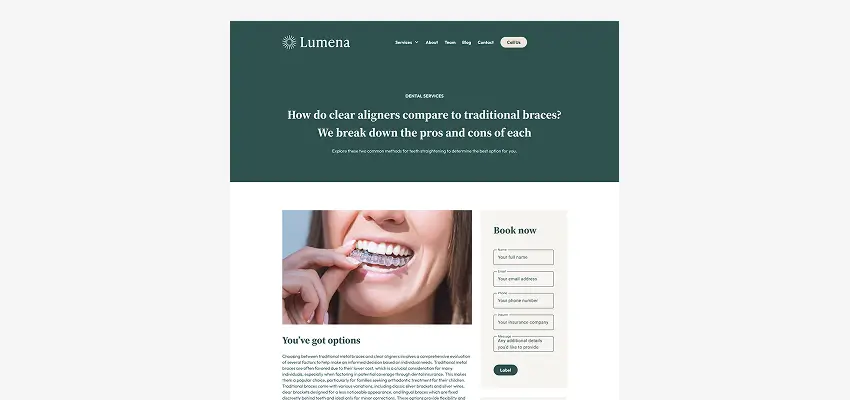
A blog is more than just a place to post updates—it’s a powerful SEO tool and a treatment acceptance booster.
Today’s patients want to self-educate before making decisions about their care. A well-written blog:
✅ Explains treatments in simple terms – Break down common conditions, symptoms, and solutions.
✅ Addresses patient concerns – Answer FAQs, tackle treatment anxiety, and remove barriers to care.
✅ Increases treatment acceptance – Patients who understand why they need a procedure are far more likely to follow through.
Regular blog content keeps your website fresh, helps with rankings, and positions you as an expert patients can trust.
Your website’s ultimate goal is getting more appointments, so making it easy to book is essential.
✅ Offer both online scheduling & call options – Younger patients often prefer online booking, while older patients are more comfortable calling.
✅ Ensure booking options are visible on every page – Don’t make patients hunt for a way to reach you.
✅ Consider live chat or text-based options – Many patients appreciate quick, low-effort ways to ask questions before committing to an appointment.
If booking is simple, patients are more likely to convert—filling your schedule faster.
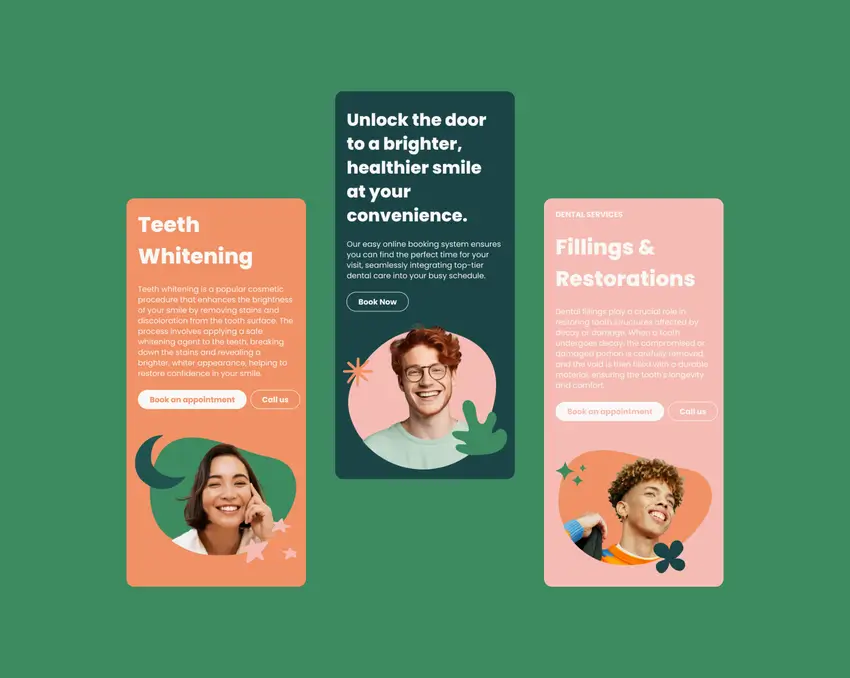
Patients use their phones constantly, especially when searching for healthcare providers.
✅ Mobile-friendly websites rank higher in Google searches – Mobile usability is a search ranking factor.
✅ Poor mobile design = lost patients – If a patient can’t easily navigate your site on their phone, they’ll look elsewhere.
✅ Most patients browse on mobile before calling – A frustrating mobile experience could cost you calls and bookings.
Flawless mobile performance isn’t just a nice-to-have—it’s a necessity.
Speed matters. If your site takes too long to load, potential patients will leave before they ever see your content.
✅ Google prioritizes fast-loading sites – Slow websites are penalized in search rankings.
✅ Patients expect instant results – If your site doesn’t load quickly, they’ll go to a competitor’s.
✅ Optimize for mobile data speeds – Many patients browse off WiFi, so your site must load well on weaker connections.
Your website should be fast, accessible, and frustration-free to keep visitors engaged.
Even the best website won’t generate new patients on its own.
In competitive markets, marketing is essential to drive traffic, improve visibility, and get patients through the door. A successful marketing plan should include:
✅ SEO strategy – Optimizing your site to rank high in search results.
✅ Paid advertising – Google Ads & social media campaigns to reach the right audience.
✅ Local reputation management – Generating and responding to patient reviews.
✅ Content marketing – Blogging, social media, and educational resources to engage & convert.
Your website is the foundation—but a strong marketing plan ensures it gets found by the right patients.
Your website is more than just a digital storefront—it’s your most powerful marketing tool.
With the right content, design, and SEO strategy, your website can attract, engage, and convert more patients than ever before.
🚀 Need a high-performing dental website? Explore our custom branding & web design solutions to stand out from the competition.
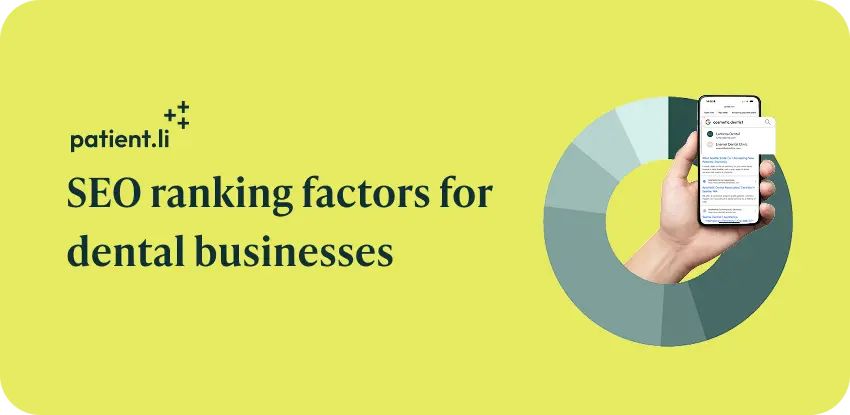
For dental practices, local SEO is a critical factor in ensuring prospective patients can easily find and choose your office. Unlike traditional SEO, which focuses on broad online visibility, local SEO is about optimizing your practice’s digital presence to rank well in searches made by nearby patients. A strong local SEO strategy improves your visibility on Google Search and Maps, increases website traffic, and drives more appointment bookings. While the technical aspects can be complex, a trusted marketing partner will focus on several key components to ensure your practice stands out.
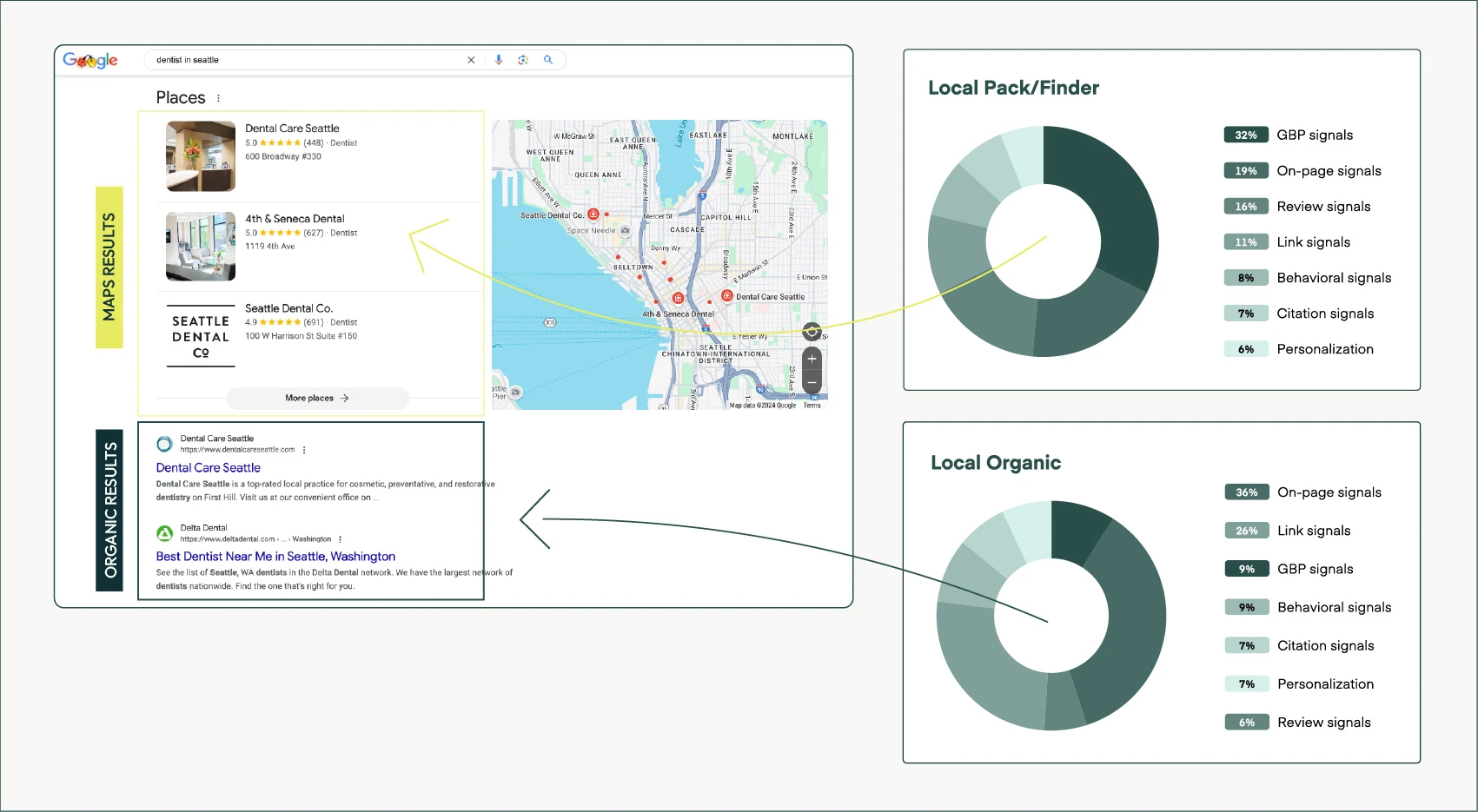
Google presents search results in two primary ways: traditional Google Search results and Google Maps results.
Google Search Results: These are the “blue links” — the primarily text-based search results that appear on the Google search page when someone searches for dental services. Ranking here depends on website optimization, content relevance, backlinks, and user engagement.
Google Maps Results: These are the results that appear in the local pack (the map section at the top of search results) and Google Maps searches. Ranking in this space relies heavily on an optimized Google Business Profile, proximity to the searcher, local citations, and patient reviews.

Both Google Search and Google Maps visibility are driven by the same set of ranking factors, but each placement weights these factors a bit differently. In the sections below, we’ll expand on each of the ranking factors that drive local visibility and note their relative importance to the Google Organic and Google Maps algorithm, as weighted by a respected SEO industry study.
Regardless of how each ranking factor is weighted, optimizing for both Google Search and Google Maps results increases the chances that a patient will end up on your website during their search process and and consider you as an option for their care. Market research published by Google shows that patients who complete an appointment booking with a provider perform, on average, 15 searches before booking with a provider, so appearing strongly in both set of results is the surest way to ensure your practice will be seen and considered as an option.
Let’s take a look at some of the specific factors that impact rankings in Google Search and Google Maps results:
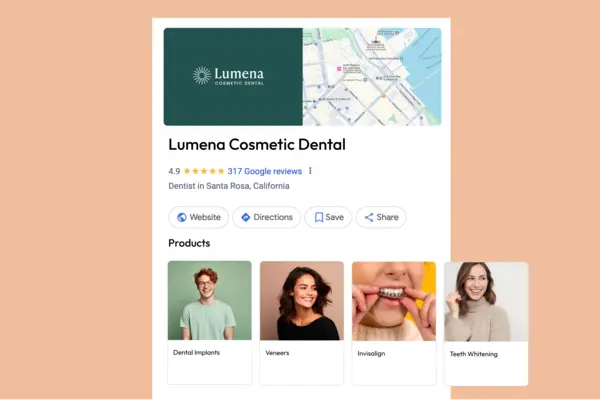
Impact on Google Maps Ranking : Highest | Impact on Google Search Ranking: Medium
One of the most influential factors in local search rankings is an optimized Google Business Profile (formerly Google My Business). This profile appears in search results and Google Maps, providing essential details about your practice, including contact information, business hours, patient reviews, photos, products and services offered and your primary business category.
A well-maintained profile ensures that Google recognizes your practice as an authoritative and relevant result for potential patients searching for dental services. Google regularly updates its features, so your team or marketing partner should actively manage and optimize your profile, keeping information accurate and incorporating tools like appointment booking links, Q&A, and Google Posts.
Beyond Google’s own ecosystem, your practice’s online reputation is influenced by external references which function as trust indicators to signal to search engines that you’re a reputable, high quality business that’s worth displaying in search results.
Local Citations: Your practice name, address, and phone number (NAP) should be consistently listed across directories like Healthgrades, Yelp, and professional association websites, like the ADA website. Google trusts businesses with uniform and accurate listings across multiple sources.
Backlinks: High-quality links from respected websites (such as dental associations, local news outlets, and industry blogs) reinforce your credibility and are an important factor in boosting rankings. Your marketing provider should identify opportunities to secure these valuable connections.
Impact on Google Maps Ranking : High | Impact on Google Search Ranking: Highest
Your website remains a cornerstone of your digital presence. While many patients may engage with your Google Business Profile before visiting your site, an optimized website still plays a crucial role in local search rankings.
A good marketing partner will ensure your website includes:
Service-specific pages with locally relevant keywords (e.g., “cosmetic dentist in [city]”)
Educational posts about symptoms, treatments and common patient questions
Optimized metadata (title tags, meta descriptions) that align with patient search intent
A mobile-friendly, fast-loading design that improves the user experience
Online reviews heavily influence both search rankings and patient decision-making. Google factors in the number, recency, and overall sentiment of reviews when determining which practices to highlight in local searches. The power of reviews is particularly potent in Google Maps rankings.
Encouraging satisfied patients to leave reviews—and responding thoughtfully to all feedback—helps build trust and signals to Google that your practice is engaged and reputable. Many marketing agencies use review management tools to streamline this process.
Impact on Google Maps Ranking : Low | Impact on Google Search Ranking: Low
Search engines track how users interact with your online presence. Metrics like click-through rates, time spent on your website, and how often patients click the call-to-action buttons on your Google Business Profile all contribute to rankings.
A well-optimized website, informative content, and clear calls to action encourage engagement, helping to improve these behavioral signals. Ensuring a smooth, user-friendly experience on mobile devices is particularly important, as many dental searches happen on smartphones.
Impact on Google Maps Ranking : Low | Impact on Google Search Ranking: Low
Google customizes search results based on factors like location and past browsing behavior. Even a well-optimized practice won’t necessarily appear at the top for all users—proximity plays a major role in who sees your listing, especially in Maps results. A strategic marketing approach ensures that your practice is optimized for both broad visibility and hyper-local searches, increasing the likelihood of capturing patients in your immediate service area.
While social media doesn’t directly impact search rankings, an active and engaged social presence can strengthen your overall brand visibility and patient trust. Patients often turn to platforms like Facebook and Instagram to verify a practice’s credibility, see real patient experiences, and interact with posts.
Maintaining a professional and approachable presence across social channels can complement your SEO efforts and drive more direct inquiries to your practice.
The best SEO strategies take an honest evaluation of your practice’s strengths and weaknesses into account for each of these ranking factors. For instance, a practice that’s just getting started and lacks a sufficient number of reviews and backlinks might have more success achieving visibility for specific services than for broader “dentist in [city]” types of searches, while an established practice with lots of website backlinks but few reviews might want to double down on a review collection strategy to improve its standing in Maps results. Understanding how your practice measures up to your competition across these ranking factors will be the first step any partner will take to helping you stand out and improve your strategy.
Maybe! With some technical wherewithal, enough time and a good set of tools, it’s possible for practices to manage their own SEO. If you’re in a less competitive area and are comfortable writing content, building a website and making changes to it, you might be able to create and manage your own strategy. If you’re uncomfortable with these tactics, or if your focus might have a higher payoff in other areas of your business, you might consider finding a partner you can trust to handle your strategy instead.
On thing that even technically-savvy practice owners often neglect to realize is that while SEO is one of the most important tactics to achieve marketing success, it’s far from the only one. Attracting patients nowadays is competitive. It requires being visible and standing out as an excellent option across the many touchpoints a patient encounters across their information search or patient journey.
Patient journeys often aren’t linear, quick or straightforward. Most patients seriously consider at least 2 options and take 2+ weeks in their search for a new provider.
Other touchpoints along the patient journey you should also pay attention to:
If you’re looking for a partner who you can trust to manage your marketing strategy, Patientli can help. We recognize that SEO is foundational to practice success, so we include SEO services in our Starter plans and up. We believe in transparency in tactics and results, so all of our strategies are based on the tactics published in this post and on the best research available about how patients use search across their patient journey.
[CTA] Marketing success requires an approach that addresses all touchpoints on the patient journey. If you’re looking for a partner who can help you stand out across all of these touchpoints, Patientli can help. See plans and pricing.

Establishing an appropriate marketing budget and deciding on the partner or team members you’ll use to execute it is one of the most important strategic decisions for a dental practice. Whether you’re handling marketing in-house or working with a service or agency you trust, dedicating the right amount of resources to attracting new patients will ensure you keep a full schedule and a healthy bottom line.
Industry benchmarks suggest that dental practices should allocate around 5% of their target annual production to marketing to maintain a steady flow of new patients. However, this percentage isn’t a hard and fast rule and can be tailored to your practice’s unique situation. The ideal budget can fluctuate based on several factors, including the competitiveness of the local market, patient acquisition goals, and the maturity of the practice. Practices in highly competitive areas may need to invest closer to 6–7% to establish visibility, while established practices with strong referral networks may be able to get away with spending 4-6% and still maintain growth.
As with everything in life, the right budget depends on your unique situation. It doesn’t make sense to spend on advertising at the expense of making payroll, nor does it make sense to drain your practice of profits while neglecting future growth, so it’s important to take these budget ranges with a grain of salt and find a level of marketing spending that’s comfortable and effective for your business.
Generally speaking, practices with mature organic search strategies are less reliant on spending on advertising, which can free up budget to use for patient retention and re-engagement strategies or to be kept as additional profit. New practices might want to set a robust budget to hit the ground running or might need to get creative to stretch their dollars as they gradually establish themselves. The most important thing a practice can do when it comes to their marketing budget is to allocate the right amount of budget for their unique situation and choose the right team member or partner to handle their marketing strategy.
Before allocating funds to specific marketing channels, practices should first determine how they will manage what typically takes up the largest share of their budget– their marketing labor. Whether hiring an external agency or building an in-house team, this decision will dictate the remaining funds available for paid advertising, software, and other marketing initiatives. As a general benchmark, practices can expect to spend 50-75% of their marketing budget on a marketing service partner or internal marketing employee. Working with a dental marketing company is typically more cost effective than having a dedicated marketing employee.
Labor isn’t the only cost associated with marketing. Practices should expect to set aside the remainder of their budget for advertising spend, software and marketing materials.
According to Dental Economics and the Levin Group, the annual production of the average dental practice is around $1.2 million. To illustrate the ideal marketing budget, let’s break down the numbers based on a marketing budget equal to 5% of production. This would amount to a total of $60,000 per year or $5,000 per month to spend on marketing. This budget would typically be divided among core marketing activities such as the practice’s website and brand, SEO strategy, advertising, content creation, social media management, reputation management, and email marketing.
While it is essential to invest in a balanced mix of marketing channels, the exact allocation should be determined in collaboration with your marketing partner to ensure alignment with your practice’s growth objectives and competitive landscape.
While a percentage-based approach provides a sound financial benchmark, marketing spend should also be evaluated relative to the level of competition in your area:
Low-Competition Areas: Practices in less saturated markets may not need to invest as heavily in paid advertising and can rely more on organic SEO, local community engagement, and word-of-mouth marketing.
High-Competition Markets: In densely populated or highly competitive regions, practices may need to invest 6–7% or more of production to outpace competitors and secure top visibility in Google search results.
Specialized Practices: If your practice offers high-value services such as dental implants, orthodontics, or cosmetic dentistry, a more aggressive marketing budget can yield a strong ROI due to higher case values.

Two Approaches to Branding for DSOs: Choosing the Right Strategy for Your Organization When launching a Dental Service Organization (DSO), one of the most important
Starting a dental service organization (DSO) is no small feat. In the crowded dental market, standing out requires more than just high-quality care—it requires a
It’s hard to overstate the importance of search engines in the patient journey. Each year, a mind-blowing 100 billion healthcare-related Google searches are made. This